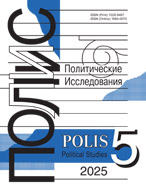Doomsday Dialectics:
the Arms Race with Arms Limitations
Arbatov A.G.,
Director, Center for International Security, Primakov National Research Institute of World Economy and International Relations (IMEMO) RAS, arbatov@imemo.ru
elibrary_id: 73079 | ORCID: 0000-0002-0354-0681 | RESEARCHER_ID: H-5017-2017
DOI: 10.17976/jpps/2019.03.03
Arbatov A.G. Doomsday Dialectics: the Arms Race with Arms Limitations. – Polis. Political Studies. 2019. No. 3. https://doi.org/10.17976/jpps/2019.03.03
The article has been supported by a grant of the Russian Science Foundation (project №18-18-00463 “Prospects of arms control under the effect of new military-political and technological factors”).
The world is sleepwalking to a fundamentally new stage in the state of international security – life in a nuclear and other arms race without any restrictions, rules and exchange of military information. The denunciation of the Treaty on the elimination of intermediate-range missiles (INF) is almost inevitable; START III Is likely to expire in 2021 without extension; and the next review conference of the Treaty on the non- proliferation of nuclear weapons (NPT) in 2020 is almost doomed to failure. However, the important experience of the past half-century is that the renunciation of treaties in this area has never enhanced the security of States, but has always weakened it. During the same time, the history of the arms race has given many examples of how the primacy in the creation of new weapons subsequently turned out to be a loss, not a gain, for the security of one side or another. The most important lesson is that nuclear deterrence can be a guarantee of peace only when combined with the maintenance and expansion of the nuclear arms control system and regimes. Today, the first priority is to save the INF Treaty, which is still possible. Then the agreement on the extension of the START III Treaty after 2021 or the urgent start of negotiations on the follow-on strategic treaty. After that, measures to strengthen the NPT. Only consistent disarmament steps in parallel with positive changes in the international political and strategic environment can enhance universal security in the coming century.
References
Acton J.M. 2013. Silver Bullet? Asking the Right Questions about Conventional Prompt Global Strike. Washington: Carnegie Endowment for International Peace. URL: http://carnegieendowment.org/2013/09/03/ silver-bullet-asking-right-questions-about-conventional-prompt-global-strike-pub-52778 (accessed 15.03.2019).
Ball D. 1972. The Strategic Missile Programme of the Kennedy Administration. Ph.D. diss. Canberra: University of Australia.
Cochran T., Arkin W., Hoeing M. 1984. Nuclear Weapons Databook. U.S. Nuclear Forces and Capabilities. Vol. I, Natural Resources Defense Council Inc. Cambridge, Massachusetts: Harper & Row, Publ., Inc.
Cochran T., Arkin W., Hoeing M. 1989. Nuclear Weapons Databook. Soviet Nuclear Weapons. Vol. IV, Natural Resources Defense Council Inc. Cambridge, Massachusetts: Harper & Row, Publ., Inc.
Einhorn R., Pifer S. 2017. Meeting U.S. Deterrence Requirements. Washington: Brookings Institution. URL: https://www.brookings.edu/wp-content/uploads/2017/09/fp_20170920_deterrence_report.pdf (accessed 15.03.2019).
Ellsberg D. 2017. The Doomsday Machine. Confessions of a Nuclear War Planner. New York: Bloomsbury.
Joint Committees on Foreign Relations and Foreign Affairs of the U.S. Senate and House of Representatives, Fiscal Year 1979. 1978. Arms Control Impact Statements. Washington, D.C.: U.S. Government Printing Office.
Kaplan F. 1983. The Wizards of Armageddon. New York: Simon and Schuster.
Newhouse J. 1989. War and Peace in the Nuclear Age. New York: Alfred A. Knopf Inc.
McNamara R. 1968. The Essence of Security: Reflections in Office. New York: Harper and Row.
Podvig P. 2013. The Development of Soviet and Russian Ballistic Missile Defense in the 20th Century. – Missile Defense: Confrontation and Cooperation. Ed. by A. Arbatov, V. Dvorkin, N. Bubnova. Moscow: Carnegie Moscow Center. P. 33-51.
SIPRI Yearbook 1990: World Armaments, Disarmament and International Security. 1991. Oxford: Oxford University Press.
Tammen R.L. 1973. MIRV and the Arms Race. New York: Praeger.
Antonov A., Ayumov R. 2012. Kontrol’ nad obychnymi vooruzheniyami v Evrope – konets rezhima ili istoriya s prodolzheniem? [Conventional Arms Control in Europe – The End of the Regime or the Story of the Continuation?]. – Nauchnye zapiski PIR-Tsentra [PIR Center’s Scientific Notes]. No. 1 (27). (In Russ.) URL: https://pircenter.org/media/content/files/9/13948093580.pdf (accessed 15.03.2019).
Gorshkov S.G. 1976. Morskaia moshch’ gosudarstva [Maritime Power of the State]. Moscow: Voenizdat. (In Russ.)
Ezhegodnik SIPRI 1998. Vooruzheniya, razoruzhenie i mezhdunarodnaya bezopasnost’ [SIPRI Yearbook 1998: Armaments, Disarmament and International Security]. 1999. Moscow: SIPRI and IMEMO RAN. (In Russ.)
Ezhegodnik SIPRI 2017. Vooruzheniya, razoruzhenie i mezhdunarodnaya bezopasnost’ [SIPRI Yearbook 2017: Armaments, Disarmament and International Security]. 2018. Moscow: Nauka. (In Russ.)
Karaganov S. 2017. O novom yadernom mire. Kak ukrepit’ sderzhivanie i sokhranit’ mir [About New Nuclear World. How to Strengthen Deterrence and Keep the Peace]. – Russia in Global Affairs. Vol. 15. No. 2. P. 8-19. (In Russ.) URL: https://globalaffairs.ru/number/O-novom-yadernom-mire-18644 (accessed 15.03.2019).
Clausewitz K. 1934. O voine [About War]. Moscow: Gosvoenizdat. (In Russ.)
Tolubko V.F. 1977. Raketnye voiska. Moscow: Voenizdat. (In Russ.)
Sistemnaya istoriya mezhdunarodnykh otnoshenii v chetyrekh tomakh, 1918-2000 [System History of International Relations in Four Volumes]. 2000. Vol. 2. Dokumenty 1910-1940-kh godov. Moscow: Moskovskii rabochii. (In Russ.)
Strategicheskoe yadernoe vooruzhenie Rossii [Strategic Nuclear Weapons of Russia]. 1998. Ed. by P. Podvig. Moscow: IzdAT. (In Russ.)
See also:
Arbatov A.G.,
The Ten Aporias of Our Time. The Theory and Practice of Nuclear Deterrence. – Polis. Political Studies. 2021. No4
Arbatov A.G.,
Nuclear boomerang. There are neither eternal allies, nor perpetual enemies, but only nuclear arms are eternal and perpetual. – Polis. Political Studies. 2025. No5
Arbatov A.G.,
Nuclear metamorphoses. – Polis. Political Studies. 2023. No5
Arbatov A.G.,
Threats to Strategic Stability – Imaginary and Real. – Polis. Political Studies. 2018. No3
Oznobishchev S.K., Klimov V.A.,
The military space race: unrealized fantasies?. – Polis. Political Studies. 2024. No6




.jpg)






 print
print
.jpg)
.jpg)